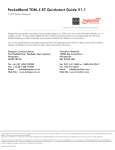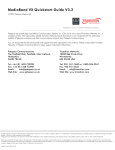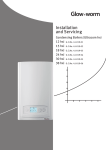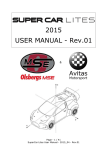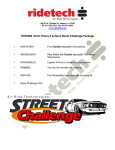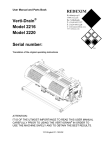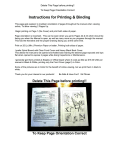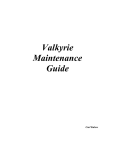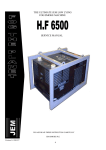Download Glide-Rite® Air Suspension
Transcript
Sprinter 2/3 Series ® Glide-Rite Air Suspension Installation Manual Mercedes Sprinter 2 / 3 Series Glide-Rite® Products Ltd Mill Lane Works Passfield Liphook Hampshire GU30 7RP Tel: +44 (0) 1428 751711 Fax: +44 (0) 1428 751677 Email: info@glide-rite.com Web: www.glide-rite.com Issue 6 – 28/11/03 Sprinter 2/3 Series Glide-Rite Products Limited INSTALLATION MANUAL AIR SUSPENSION SYSTEM FOR MERCEDES SPRINTER 2/3 SERIES CONTENTS Section 1. SUSPENSION 2. AIR PARTS 3. WIRING 4. PIPING 5. EXHAUST SYSTEM 6. COMMISSIONING Title Issue Pages Date Contents Revision History 4 4 1 1 28/11/03 28/11/03 App. A Safety First 3 1 24/09/01 1.1 1.2 1.3 1.4 1.5 1.6 2.1 2.2 2.3 2.4 2.5 2.6 2.7 2.8 2.9 3.1 3.2 4.1 4.2 5.1 6.1 6.2 6.3 Suspension Preparation Air Bag Bracketry Springs Panhard Rod and Alignment Air Bags Brake Piping Load Sensing Valve Ride Height Valve Compressor Box Mounting Air Tank Assembly Air Tank Mounting Mist Separator Economy Valve Schrader Valve Auto-Drain Valve Wiring Wiring Diagram Piping Piping Diagram Exhaust Modifications Charging Sequence Operation Checks Check List 3 3 3 3 3 1 3 4 3 4 3 3 3 3 3 3 5 4 3 4 3 3 3 1 1 1 2 1 1 1 1 1 1 1 1 1 1 1 1 1 1 1 1 1 1 1 24/09/01 24/09/01 24/09/01 24/09/01 24/09/01 28/11/03 24/09/01 28/11/03 24/09/01 17/01/02 24/09/01 24/09/01 24/09/01 24/09/01 24/09/01 24/09/01 28/11/03 17/01/02 24/09/01 17/01/02 24/09/01 24/09/01 24/09/01 App. B App. B1 App. D Torque Settings ‘U’ Bolt Torque Sequence Anti-Corrosion Treatment 3 1 3 1 1 1 24/09/01 08/03/02 24/09/01 Issue 4 – 28/11/03 Sprinter 2/3 Series Glide-Rite Products Limited INSTALLATION MANUAL AIR SUSPENSION SYSTEM FOR MERCEDES SPRINTER 2/3 SERIES REVISION HISTORY Date Description 24/09/01 Revised version of Installation Manual - v3 issued to reflect new document control methodology incorporating Contents and Revision History documents – v1. 17/01/02 Issue 4 produced to reflect revisions to following sections: Sect 2.4 (v4) includes a new paragraph 2.4.2 with a note explaining the use of a new air tank drain plug adaptor to ensure ground clearance; Sect 3.2 (v4) evidences a new rear door switch and some wire colour changes shown in fig 3.2.1a; Sect 4.1 (v4) includes a new paragraph 4.1.3 with fig 4.1.3a, which addresses clear labelling for correct component piping, as shown on compressor box; and section 5.1 (v8) which evidences greater detail for the exhaust pipe modification if applicable. These revisions are incorporated in Contents –v2 and Revision History –v2. 08/03/02 Issue 5 produced to address Sect 5.1 (v4) which evidences greater detail for the exhaust pipe modification if applicable and the addition of Appendix B1 which clarifies the procedure for tightening ‘U’ bolts and incorporates Contents –v3 and Revision History –V3. 28/11/03 Issue 6 produced to reflect new section: Sect 1.6 (v1) evidencing change of introduction of longer brake pipes to ensure greater flexibility during lowering and raising of suspension; Sect 2.2 (v4) evidences the inclusion of a ride height valve extension arm; Section 3.2 (v5) evidences a new wiring diagram which includes an updated latch relay and timer control unit; Appendix C Fault-finding has been deleted as this area is covered in greater detail in the ‘Maintanence and Service Manual’. These revisions are incorporated in Contents –v4 and Revision History –v4. Glide-Rite Products Limited Document Control and Approval This is a controlled document. Any amendment or revision to this document will be notified to the copy holder, thereby ensuring that the document is maintained in a fully updated version at all times. The approval of this document, in its latest revision, is given by: Name: Mark Glazier Position: Technical Director Signed: ……………….. Dated: 28/11/03 Issue 4 – 28/11/03 Sprinter 2/3 Series Appendix A Safety First Read and follow all warnings Never disregard warning instructions: follow them at all times. Read and follow the instructions printed on labels or signs fixed to the vehicle, components or containers. Support vehicle securely Never carry out any work under the vehicle unless it is raised and securely supported on a properly rated garage lift or jack and axle stands. Always work safely Never tamper with brake lines, fuel pipes or electrical wiring unless instructed to do so. Disconnect the battery before starting work on any vehicle. Always follow the vehicle manufacturer’s service instructions when carrying out work on a vehicle. Always work in a clean, tidy and methodical manner. Seek help with heavy items Do not lift heavy items unaided - always seek assistance. Be aware of the limits set out in the Manual Handling Regulations. Fuel is dangerous if handled carelessly Never allow fuel tanks or lines to be exposed to sparks, heat or weld spatter. Diesel is FLAMMABLE. Petrol is HIGHLY FLAMMABLE and its vapour is EXPLOSIVE. Drain fuel tanks and lines before starting work. Always work in a well ventilated area when dealing with fuels. Wear protective clothing Tie back long hair and remove ties, loose clothing and jewellery before using power tools. Wear eye protection and steel toe-cap shoes. Use ear defenders if necessary. Use the correct shield and protective clothing when welding. Avoid being ‘flashed’. Exhaust gas is dangerous Exhaust gas contains carbon monoxide which itself has no colour or odour. Carbon monoxide can cause unconsciousness and can be lethal. Do not run engines in confined spaces such as garages unless an exhaust extractor can be used. High pressure can injure Drain air systems completely before disconnecting any part. Electrical safety Disconnect battery before working on any electrical system. Never fit electrical parts or wires where they could come into contact with fuel pipes or tanks. Check that pipes are not chafed or damaged by sharp edges on the vehicle. If the vehicle is fitted with other non-standard electrical equipment (e.g. tail lift), consult a qualified auto-electrician or contact the Glide-Rite Technical Helpline +44 (0) 1428 751711. Issue 3 – 24/09/01 Sprinter 2/3 Series 1. SUSPENSION 1.1 SUSPENSION PREPARATION 1.1.1 1.1.2 Jack up vehicle and place body on axle stands – see fig 1.1.2a. Support axle with trolley jack and remove wheels – see fig 1.1.2a. fig 1.1.2a 1.1.3 Remove anti-roll bar tie rod upper mounting bolts and store – see fig 1.1.3a. fig 1.1.3a 1.1.4 1.1.5 1.1.6 1.1.7 Remove upper shock absorber bolts and retain. Remove both leaf springs, ‘U’ bolts and rear shackles and discard. Keep both top ‘U’ bolt plates for later use. Remove rear section of exhaust pipe. Panel Van Version The exhaust system will require modification of the rear section. IMPORTANT – THE EXHAUST SYSTEM MUST BE MODIFIED TO DIVERT IN FRONT OF REAR WHEEL (Available from Glide-Rite and Mercedes Benz) OR MODIFIED TO EXIT AT REAR OF VEHICLE Issue 3 – 24/09/01 Sprinter 2/3 Series 1. SUSPENSION 1.2 AIR BAG BRACKETRY 1.2.1 Take rear air bag frame and slide up over chassis rail. Remove underseal from chassis rail and fit from which may require locating with a soft face hammer. Note alignment - see fig 1.2.1b. fig 1.2.1a fig 1.2.1b Rear Left Right Front 1.2.2 Once frame is in place, using the original anti-roll bar tie rod bolts, bolt through rear air bag frame and original anti-roll bar mounts with anti-roll bar tie rod in position – see fig 1.2.2a. Tighten to 95 Nm. fig 1.2.2a 1.2.3 Carry out same operation on front air bag frame, using upper shock absorber bolts, noting alignment shown in fig 1.2.3a. fig 1.2.3a 1.2.4 Re-fit upper shock absorber bolts, replacing the left-side bolt with M14 x 160mm bolt – see fig 1.2.4a. Tighten to 80 Nm. fig 1.2.4a Issue 3 – 24/09/01 Sprinter 2/3 Series 1. SUSPENSION 1.3 SPRINGS 1.3.1 Fit left and right springs. Note:- They are handed – see fig 1.3.1a. Left Right fig 1.3.1a 1.3.2 Fit new ‘U’ bolts (77990051) and original ‘U’ bolt plates to left spring and nip up nuts – ONLY HAND TIGHTEN AT THIS POINT. 1.3.3 Fit panhard rod cradle to right rear spring to align with rear ‘U’ bolt. 1.3.4 Use longer ‘U’ bolt through panhard rod cradle, clamping panhard rod cradle to spring. Then bolt the two rear holes with M10 x 50mm bolts, M10 nyloc nuts and M10 washers. WARNING - DO NOT OVER TIGHTEN ‘U’ BOLTS AT THIS STAGE Issue 3 – 24/09/01 Sprinter 2/3 Series 1. SUSPENSION 1.4 PANHARD ROD AND ALIGNMENT 1.4.1 Take panhard rod assembly and bolt to left side mounting using M12 x 90mm bolt, M12 nyloc nut and M12 washer. Bolt track rod end to right side bracket – see figs 1.4.1a-b. fig 1.4.1a fig 1.4.1b left right THIS IS AN IMPORTANT SET UP MEASUREMENT. 1.4.2 Jack up vehicle to obtain a measurement of 240mm between rear air bag plates – see fig 1.4.2a. fig 1.4.2a 1.4.3 240 mm+0.0 300mm -10.0 REAR AIR BAG Now measure between wheel rim and chassis on both sides – see fig 1.4.3a. This measurement MUST be equal and is achieved by rotating panhard rod to increase or decrease length. fig 1.4.3a 164.0 – 2.0mm Distance from chassis to wheel rim (same both sides) Distance adjustable by lengthening or shortening panhard rod Issue 3 – 24/09/01 Sprinter 2/3 Series 1. SUSPENSION 1.4 PANHARD ROD ALIGNMENT (cont) 1.4.4 Tighten M20 lock nuts on both ends of the panhard rod and fit split pin – fig 1.4.4a. Note that track rod end has left hand thread. Note:- paint threads so tightness can be checked visually. fig 1.4.4a 1.4.5 Make sure that track rod end has room to articulate side to side – see diagrams 1.4.4b-d. fig 1.4.5b fig 1.4.5a Correct 90º Wrong 90º fig 1.4.5c Wrong 1.4.6 Torque all bolts to correct torque setting: 1) Front spring bolts – 90 Nm 2) ‘U’ bolts – 170 Nm 3) Upper shock absorber bolts 80 Nm 4) Anti-Roll bar bolt 110 Nm Issue 3 – 24/09/01 Sprinter 2/3 Series 1. SUSPENSION 1.5 AIR BAGS 1.5.1 Take front air bag and screw in male branch tee 6mm x R1/4. Then screw 90 degree male elbows 6mm x R1/4 into rear air bag. Use sealant on ALL threads of fittings. Tighten to 13 Nm. fig 1.5.1a 1.5.2 AD AD AE Bolt air bags using 3/8 UNC x 3/4 bolts and M10 spring washers to top air bag brackets – see fig 1.5.2a. Tighten to 20 Nm – use set of holes closest to chassis. fig 1.5.2a 1.5.3 Take 4 lower air bag plates and 3 x 3/8 x 1 3/4 UNC bolts and M10 spring washers. Place air bag plate between air bag base and spring, then bolt into place using bolts up through spring into air bag base. Hold plastic base as you tighten to 20 Nm. You will need to jack up the axle to carry out this operation. Then place 3/8 x 2 3/4 UNC bolt the right rear air bag hole through panhard rod cradle and torque to 20 Nm. Issue 3 – 24/09/01 Sprinter 2/3 Series 1. 1.6 SUSPENSION BRAKE PIPING 1.6.1 Remove the existing short flexible brake pipe section running from the bracket pipe bracket on the chassis to the brake calliper. Note:- the end of the remaining brake pipe should be plugged to prevent excessive brake fluid loss. 1.6.2 Take new longer flexible brake pipe section and fit in place of original brake pipe, ensuring that pipe is routed via ‘P’ clip which must be attached to the upper air bag frame – see figs 1.6.2a-b. Fig 1.6.2a New brake pipe section Fig 1.6.2b Remaining brake pipe attached to chassis bracket 1.6.3 Repeat operation on both sides and bleed brakes in accordance with standard workshop procedure. Issue 1 – 28/10/03 Sprinter 2/3 Series 2. AIR PARTS 2.1 Load Sensing Valve (Non ABS Vehicles Only) 2.1.1 Remove original LSV linkage from vehicle. Assemble LSV air bag assembly to bracket – see fig 2.1.1a. Screw a 90 degree male elbow 6mm x R1/4 into each end of air bag assembly – see fig 2.1.1a. Use sealant on ALL threads of fittings. fig 2.1.1a 99900022 77990024 77990040 77990011 77990010 2.1.2 Remove original LSV mounting bolts, position new LSV bracket assembly and bolt into place using M8 x 35mm bolts. Tighten to 21 Nm – see fig 2.1.3a. 2.1.3 Use M8 x 25mm bolt , M8 nyloc nut and M8 washer to bolt LSV arm extension to original LSV arm – note:- plastic bush in original LSV arm needs to be removed before assembling. fig 2.1.3a M8 x 25 bolt (99900023) attaching LSV arm to LSV extension Issue 3 – 24/09/01 Sprinter 2/3 Series 2. AIR PARTS 2.2 RIDE HEIGHT VALVE 2.2.1 Take ride height valve, turn arm 3 times clockwise and 3 times anti-clockwise to settle fluid in unit, then screw in 2 x 90 degree male elbows 6mm x R1/8. Ensure fine mesh filter is fitted – see fig 2.2.1a. Use sealant on all threads. fig 2.2.1a Top fig 2.2.1b Fine mesh filter Middle Bottom 2.2.2 Fit ride height valve to rear cross member in pre-drilled holes and fit new ride height valve linkage between axle and ride height valve extension arm – see fig 2.2.2a fig 2.2.2a Issue 4 – 28/11/03 Sprinter 2/3 Series 2. AIR PARTS 2.3 COMPRESSOR BOX MOUNTING 2.3.1 Mount compressor box to left and right side mounting brackets using M6 x 25 bolts, M6 nuts and M6 washers – see figs 2.3.1a-b. fig 2.3.1a M6 x 25mm bolts fig 2.3.1b Lid faces this way Compressor Brackets Compressor 2.3.2 Mount compressor box assembly to chassis using M6 x 25 bolts, M6 nuts and M6 washers, ensuring correct spacing measurement – see fig 2.3.2a. fig 2.3.2a Chassis Lid faces this way Compressor Box Assembly 140mm Panel van version For panel vans the box can be bolted to the vehicle floor without using the compressor box mounting brackets, using M6 x 25 bolts, M6 nuts and M6 washers. Issue 3 – 24/09/01 Sprinter 2/3 Series 2. 2.4 AIR PARTS AIR TANK ASSEMBLY 2.4.1 Screw M22 x 1/4 adaptors into the 2 ports on one end of the air tank, using sealing washers, ‘O’ rings and air sealant on all threads – see figs 2.4.1a-c. Then screw 2 x 90 degree male elbows 6mm x R1/4 into the adaptors, again using sealant on all threads – see fig 2.4.1d. Then screw one M22 plug into the remaining end port. fig 2.4.1a fig 2.4.1b fig 2.4.1c fig 2.4.1d 2.4.2 Take M22 x 1.5mm drain plug adaptor and fit to bottom of tank, using sealing washer, ‘O’ ring and sealant as above. Then fit 1/8 filter and 1/8 straight air fitting into plug, using sealant on thread – see fig 2.4.2a. Note:- This adaptor must be used on the underside of tank to ensure sufficient ground clearance. fig 2.4.2a Issue 4 – 17/01/02 Sprinter 2/3 Series 2. AIR PARTS 2.5 AIR TANK MOUNTING 2.5.1 Fit air tank straps to air tank bracket using M10 x 30mm bolts, M10 nyloc nuts and M10 washers – see fig 2.5.1a. fig 2.5.1a 2.5.2 Bolt air tank bracket assembly to chassis using M6 x 25mm bolts, M6 nyloc nuts and M6 washers – see fig 2.5.2a. fig 2.5.2a 2.5.3 Now bolt tank into place making sure that the centre bottom elbow faces towards the ground as this is the auto drain output port – see fig 2.5.2a. Tighten clamps to 60 Nm. Panel van versions For panel vans the tank should be mounted to the chassis rail using air tank straps on the right chassis section out board of chassis rail. Issue 3 – 24/09/01 Sprinter 2/3 Series 2. AIR PARTS 2.6 MIST SEPARATOR 2.6.1 Attach mist separator to mist separator bracket and fit 90 degree male elbows 6mm x R1/4 to 3 ports – see fig 2.6.1b. Screw to chassis between air tank and ride height valve using No.6 self-drilling screws – see fig 2.6.1a. fig 2.6.1a fig 2.6.1b Issue 3 – 24/09/01 Sprinter 2/3 Series 2. AIR PARTS 2.7 ECONOMY VALVE 2.7.1 Assemble economy valve with 90 degree male elbow 6mm x R1/4 and 1/4 bung 2.7.2 Mount the assembled economy valve to the bracket and fix to the chassis above the axle on right side of vehicle. Position so that the plunger is depressed when the suspension is lowered on its bump stops. Use self drill bolts to mount to chassis – see fig 2.7.2a. fig 2.7.2a fig 2.7.2b CHASSIS BRACKET ECONOMY VALVE POSITIONED SO PLUNGER IS DEPRESSED WHEN VEHICLE IS FULLY LOWERED BUMP STOP Issue 3 – 24/09/01 Sprinter 2/3 Series 2. AIR PARTS 2.8 SCHRADER VALVE 2.8.1 Mount schrader valve and compressor filter to bracket using attached air fittings as shown in fig 2.8.1a. Use sealant on all threads. Fig 2.8.1a 2.8.2 Mount bracket under bonnet so that schrader valve faces outwards and is fully accessible in emergencies. This valve is to be used to fill the air suspension system to a maximum pressure of 120psi (8bar), if the system is drained completely. WARNING - If maximum pressure is exceeded it will cause suspension component damage Issue 3 – 24/09/01 Sprinter 2/3 Series 2. AIR PARTS 2.9 AUTO-DRAIN VALVE 2.9.1 Mount Auto-Drain valve on bracket using M3 bolts, M3 nuts and M3 washers – see fig 2.9.1a. fig 2.9.1a 2.9.2 Mount bracket and valve in suitable location in close proximity to tank, using No.6 self-drilling bolts. Issue 3 – 24/09/01 Sprinter 2/3 Series 3. 3.1 WIRING WIRING 3.1.1 Wire system as per vehicle wiring diagram 3.2. Install relay and fuse holder, so that they are visible when the plastic cover is removed, and screw latch relay to floor under driver’s seat in auxiliary wiring section – see figs 3.1.1a-b. fig 3.1.1a Fuse block fig 3.1.1b Relay block Latch Relay 3.1.2 Route wiring from under driver seat fuse box, via passenger seat grommet to compressor box at rear of vehicle. Use cable ties to secure conduit to chassis and keep away from hot engine areas and exhaust. Route wires to rear left side chassis area, connect rear switch to wiring, place in plastic bag and coil up ready for body builder to use inside vehicle (leave excess wire at rear). 3.1.3 Protect all exposed wires with plastic conduit and seal joints with insulating tape. 3.1.4 Release switch bezel assembly and remove switch blanking plate. Fit new switch – see fig 3.1.4a Wire as detailed in vehicle wiring diagram 3.2.1a fig 3.1.4a Panel van version Route wires inside rear door pillar and mount switch in suitable place. Issue 3 – 24/09/01 Sprinter 2/3 Series 3. 3.2 3.2.1 fig 3.2.1a WIRING WIRING DIAGRAM Wiring Diagram for Mercedes Sprinter 3 & 4 Series Issue 5 – 28/11/03 4. PIPING 4.1 PIPING 4.1.1 Pipe system as per piping diagram fig 4.2.1. Use pipe cutters so that all cuts are square. All air pipe should be protected with conduit, cable tied away from ground and exhaust pipe. Pipe MUST NOT be bent, allowing only the natural curve of the pipe. Note direction of air-flow when installing one-way valve and mist separator unit. 4.1.2 Install one-way valve between the mist separator and ride height valve. 4.1.3 To ensure that the compressor is piped correctly, each bulkhead connector on the compressor box is clearly labelled with the corresponding component – see fig 4.1.3a fig 4.1.3a Issue 7 – 18/01/02 Sprinter 2/3 Series 4. 4.2 PIPING PIPING DIAGRAM 4.2.1 Issue 4 – 17/01/02 Sprinter 2/3 Series 5. 5.1 EXHAUST SYSTEM EXHAUST PIPE MODIFICATIONS (if required) Note:- If the vehicle requires an exhaust modification follow the instructions below, otherwise proceed to section 6.1. To order exhaust modification kit contact Glide-Rite. 5.1.1 5.1.2 Measure from behind the original exhaust box and cut off excess pipe to retain 220mm of original pipe – see fig 5.1.2a. Ensure that cut is as straight as possible to create a good seal. Fit new exhaust pipe and attach using exhaust clamp – see fig 5.1.2a fig 5.1.2a 5.1.3 Fit new hanger bracket to chassis 220mm as shown in fig 5.1.3a fig 5.1.3a 5.1.4 Fit stabiliser bracket between chassis and new exhaust tail pipe as shown in fig 5.1.4a fig 5.1.4a 5.1.5 Start vehicle and check for exhaust leaks from joints. Issue 4 – 17/01/02 Sprinter 2/3 Series 6. COMMISSIONING 6.1 CHARGING SEQUENCE 6.1.1 Using schrader valve, pressurise system to 120 psi (8 bar). WARNING do not overcharge as this will result in component damage. 6.1.2 6.1.3 6.1.4 6.1.5 6.1.6 6.1.7 Turn on ignition. Run compressor until it cuts out automatically. Jack up rear axle. The ride height valve will now allow air into air bags and this will take the weight off axle stands. Replace and torque road wheels to 180 Nm. Remove axle stands and lower vehicle to ground. Measure clearance between rear air bag top and bottom mounting plates – see fig 6.1.7a fig 6.1.7a fig 5.1.1b 240mm +0.0 300mm (+0 -10) -10.0 REAR AIR BAG The measurement should be 240mm and not less than 230mm. Adjust by slackening off bolt on ride height valve arm and moving ride height valve arm up or down. 6.1.8 Check all joints on air pipes by spraying with soapy water. If there are any leaks, bubbles will appear. To remedy leaks, re-cut pipe and re-seal joints. Issue 3 – 24/09/01 Sprinter 2/3 Series 6. 6.2 COMMISSIONING OPERATION CHECKS 6.2.1 Apply handbrake. The system will not operate unless the handbrake is applied. 6.2.2 Operate front or rear down switch. 6.2.3 The system will now lower and a hissing noise will be heard as the vehicle lowers and the auto-drain valve exhausts. When the vehicle hits the bump stops, the air will stop exhausting (this is the economy valve unit working)– see fig 6.2.3a. fig 6.2.3a 6.2.4 Depress up switch or release the handbrake and the system will rise – see fig 6.2.4a. fig 6.2.4a 6.2.5 Re-check air bag measurements – see fig 6.1.7a. For fine adjustment slacken off nut, then adjust as required - see fig 6.2.5a. fig 6.2.5a IMPORTANT: With the vehicle lowered the following clearances MUST be maintained: 1) 5MM BETWEEN UNDERSIDE OF VEHICLE FLOOR AND PLASTIC BALL JOINT ON RIDE HEIGHT VALVE ARM. 2) 5MM CLEARANCE AROUND ALL BRAKE PIPES AND HANDBRAKE CABLES. Issue 3 – 24/09/01 Sprinter 2/3 Series 6. COMMISSIONING 6.3 CHECK LIST 6.3.1 Road test. 6.3.2 Attach foil serial number to base of driver’s seat by chassis plate 6.3.3 Stickers – Operation stickers to be positioned on inside of rear and front door close to operating switch. 6.3.4 Perspex Glide-Rite badge to be stuck on the rear door of vans – see fig 6.3.4a. Chassis cabs - leave badge unfitted and put in glove box for body builder to affix fig 6.3.4a 6.3.5 Demonstrate air suspension and operating technique to customer. Note:- As a safety feature, the suspension will not operate without the handbrake being engaged & will always raise when the handbrake is released (some vehicles with their ignition turned on). 6.3.6 Provide customer with User Guide. Glide-Rite Technical Helpline : tel. +44 (0) 1428 751711 Issue 3 – 24/09/01 Sprinter 2/3 Series Appendix.B TORQUE SETTINGS APPLICATION SIZE SPEC TORQUE Road Wheels (wheel nuts) Upper Shock Absorber Bolts Lower Shock Absorber Bolts Top Air Bag Bolts Lower Air Bag Bolts Original Original Original 3/8 x 3/4 3/8 x 1 3/4 & 3/8 x 2 3/4 Original Merc Merc 8.8 180 NM 80 NM 70 NM 20 NM 20 NM Merc M12 x 100 M6 x 25 M6 x 25 M6 x 25 8.8 8.8 8.8 M10 x 100 M8 x 25 M8 x 20 5/8 x 11 UNC M4 x 10 M4 x 10 8.8 8.8 8.8 90 NM 170 NM Alignment of Split Pin 95 NM 10 NM 10 NM 10 NM 60 NM 40 NM 24 NM 24 NM Hand Tight 2 NM Hand Tight NO TWISTING OF MOUNT Compression of Rubber Seals 8 NM 13 NM 10 NM Front Spring Bolts ‘U’ Bolts Panhard Nut & Split Pin Panhard Fixing Bush End Ride Height Valve Mounting Compressor Bracket Compressor Box Mounts Air Tank Strap M10 Tank Strap Bolt ( mounting) LSV Mounting Bolts LSV Arm Bolt Fixing & Nut Air Bag Nut LSV Solenoid Bolts Pressure Switch Compressor Mounts Air Tank Fittings Air Tank 1/8 Thread Air Tank 1/4 Thread Regulator Bracket Bolt Connecting Rod To Stabiliser & Frame Longitudinal Member (rear axle) Bolt Stabiliser Clamp To Rear Axle Tube Bolt Connecting To Stabiliser Clamp (rear axle) M6 x 16 Original Original Original 10.9 110 NM 25 NM 25 NM Issue 3 – 24/09/01 Sprinter 2/3 Series Appendix.B1 ‘U’ BOLT TORQUE SEQUENCE These ‘U’ Bolts must be tightened evenly. When torqued to the correct setting, an equal number of threads should be exposed. Tightening Sequence Fig 1 Side View 1 Tighten nuts 1, 2, 3 and 4 evenly until spring is sitting flat on axle plate – see figs 1 and 2. 2 Torque nuts 1, 2, 3 and 4 to 30Nm and check that thread length is equal. 3 Then torque nuts 1, 2, 3 and 4 to 70Nm and check that thread length is still equal. 4 Finally torque nuts 1, 2, 3 and 4 to full torque setting (see table 5) View from underneath Fig 2 Front Fig 3 1 3 2 4 Rear Checking Procedure 1 If ‘U’ bolts are fitted as per fig 3, replace nyloc nuts and refit as per above tightening sequence until the result is as per fig 4. 2 If ‘U’ bolts are already fitted as per fig 4, check torque only if retorqueing is required. If this is the case replace nylocs and torque as per above tightening sequence. Torque Settings Fig 4 Table 5 Vehicle Mercedes Sprinter (all models) Torque 170Nm Issue 1 – 08/03/02 Sprinter 2/3 Series Appendix D. ANTI-CORROSION TREATMENT AND PAINTWORK The following procedure should be followed in order to restore any broken surface to manufacturer’s original specification. 1. Remove any flaky paintwork and clean the surrounding area to leave no traces of grease, dust or other contamination, using a heptane type solvent. 2. Apply two coats of a proprietary zinc-free primer. 3. Rub down the primed surfaces before applying a minimum of two top coats of original matched colour or underseal. 4. All painted areas should be finished with a good application of protective wax seal. 5. In the event of any treatment to exterior paint surfaces, it is important to check the opposing INTERIOR surface for any paintwork damage and need for repair. Issue 3 – 24/09/01
































